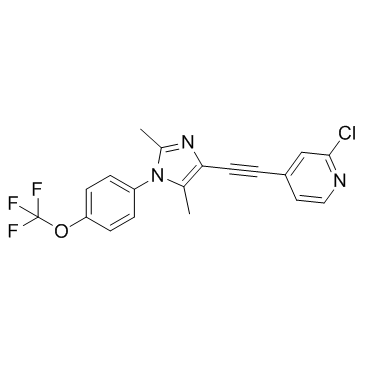871362-31-1
| Name | 2-chloro-4-[2-[2,5-dimethyl-1-[4-(trifluoromethoxy)phenyl]imidazol-4-yl]ethynyl]pyridine |
|---|---|
| Synonyms |
CS-0974
CTEP 2-chloro-4-((2,5-dimethyl-1-(4-(trifluoromethoxy)phenyl)-1H-imidazol-4-yl)ethynyl)pyridine |
| Description | CTEP is a novel, long-acting, orally bioavailable allosteric antagonist of mGlu5 receptor with IC50 of 2.2 nM, and shows > 1000-fold selectivity over other mGlu receptors. |
|---|---|
| Related Catalog | |
| Target |
IC50: 2.2 nM (mGlu5 receptor) |
| In Vitro | CTEP inhibits quisqualate-induced Ca2+ mobilization with an IC50 of 11.4 nM and [3H]IP accumulation with an IC50 of 6.4 nM in HEK293 cells stably expressing human mGlu5. CTEP inhibits the constitutive activity of human mGlu5 by approximately 50% with an IC50 of 40.1 nM in HEK293 cells stably expressing human mGlu5[1]. |
| In Vivo | CTEP is significantly active at doses of 0.1 mg/kg and 0.3 mg/kg in treatment of anxiety in mouse. CTEP significantly increases drinking time at doses of 0.3 mg/kg and 1.0 mg/kg in the Vogel conflict drinking test in rat, whereas it has no effect at lower doses. The half-life of CTEP (oral) is 18 h, and the B/P ratio based on total drug concentrations in plasma and whole brain homogenates is 2.6 in mice. After single oral doses of 4.5 and 8.7 mg/kg CTEP formulated as microsuspension in a saline/Tween vehicle administrated to adult C57BL/6 mice is rapidly absorbed and achieves close to maximal exposure after approximately 30 min. Chronic administration in adult mice with a dose of 2 mg/kg p.o. every 48 h for 2 months reaches a minimal CTEP brain exposure of 240 ng/g. CTEP fully displaces [3H]ABP688 in mouse brain regions known to express mGlu5, and 50% displacement is achieved with doses producing an average compound concentration of 77.5 ng/g measured in whole brain homogenate[1]. CTEP (2 mg/kg, p.o. bid) achieves uninterrupted mGlu5 occupancy per 48 hours in mice. CTEP (2 mg/kg, p.o.) treatment corrects elevated hippocampal long-term depression, excessive protein synthesis, and audiogenic seizures in the Fmr1 knockout mouse[2]. |
| Kinase Assay | For all filtration radioligand binding assays, membrane preparations expressing the target receptors or receptor combinations are resuspended in radioligand binding buffer (15 mM Tris-HCl, 120 mM NaCl, 5 mM KCl, 1.25 mM CaCl2, and 1.25 mM MgCl2, pH 7.4), and the membrane suspension is mixed with the appropriate concentrations of radioligand and nonlabeled drugs in 96-well plates in a total volume of 200 μL and incubated for 60 min at the appropriate temperature. At the end of the incubation, membranes are filtered onto Whatman Unifilter preincubated with 0.1% polyethyleneimine in ish buffer (50 mM Tris-HCl, pH 7.4) with a Filtermate 196 harvester and washed three times with ice-cold ish buffer. Radioactivity captured on the filter is quantified on a Topcount microplate scintillation counter with quenching correction after the addition of 45 μL of MicroScint 40 per well and shaking for 20 min. The concentration of membranes and incubation time is determined for each assay in pilot experiments. |
| Animal Admin | Adult male Sprague-Dawley rats (body weight approximately 180-210 g) and male NMRI mice (body weight approximately 25 g) are supplied by Charles River. Rats are group-housed and mice are-single housed in separate holding rooms at controlled temperature (20-22°C) and 12-h light/dark cycle (lights on 6:00 AM). Animals are allowed ad libitum access to food and water, with the exception of those used in the Vogel conflict drinking test, where access to water is limited during the training sessions as described below. All formulations are prepared immediately before use in vehicle, consisting of 0.9% NaCl (w/v) and 0.3% Tween 80 (v/v) solution for oral administration of CTEP, MPEP, MTEP, and fenobam; 0.9% NaCl solution for MPEP and MTEP intravenously; and 30% N-methylpyrrolidone, 42% hydroxypropyl-γ-cyclodextrin, and 28% water for fenobam intravenously. The volume of administration for oral dosing is 5 mL/kg for rats, 10 mL/kg for mice, and 2.5 mL/kg for intravenous applications and 10 mL/kg for subcutaneous applications in mice. |
| References |
| Molecular Formula | C19H13ClF3N3O |
|---|---|
| Molecular Weight | 391.77400 |
| Exact Mass | 391.07000 |
| PSA | 39.94000 |
| LogP | 4.83590 |
| Storage condition | -20℃ |
